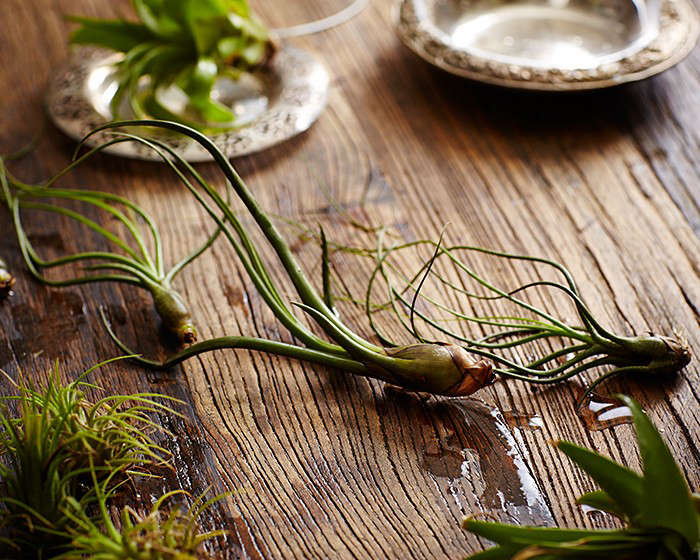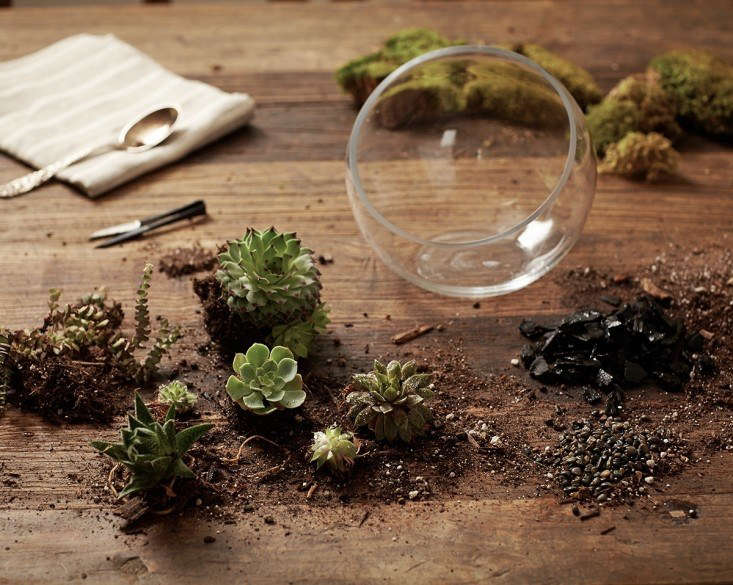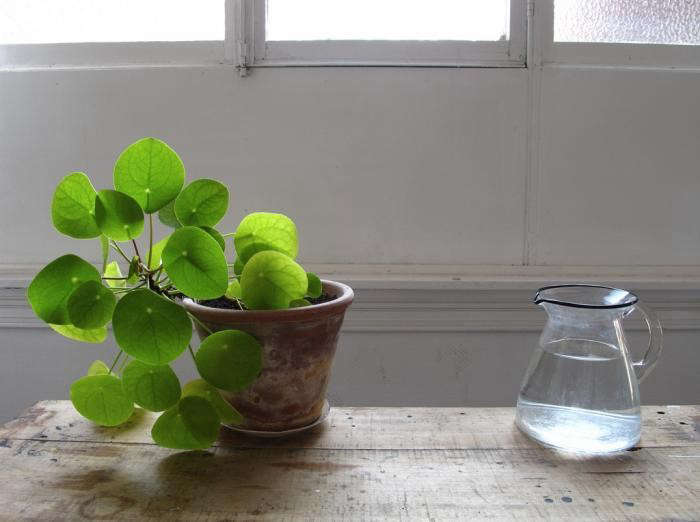Are you tired of hearing the same old obvious tips about how to take care of houseplants? We certainly are. These days the Internet seems to regurgitate more than it enlightens. Not this time. I put on my sleuthing hat to coax experts to reveal their secrets for growing plants indoors.
Have you ever wondered how to repot a spiny, sharp cactus or how Instagrammers actually persuade those vines to climb a kitchen wall to drape cunningly over a shelf of mugs? Here are the answers—10 secrets to successful houseplants:
1. How to Repot a Cactus

If you’ve tried to repot a cactus, you’ll know it can be agony: it’s nigh-on impossible to avoid a run-in with all those spines. Often the advice is to wrap a strip of newspaper around the plant, but this isn’t particularly effective. Instead, be inspired by Stan Griffin and Vicki Newman of Chelsea flower show exhibitors Craig House Cacti in West Bromwich, England, who wrap cacti in bubble wrap when repotting.

2. How to Propagate String of Hearts

3. How to Feed an Air Plant

We’re all clued into the fact that although air plants may not need watering like conventional plants, they do need misting regularly (if the leaf edges begin to roll up, that’s a sign they’re too dry). But did you know that if you want to get fat, healthy Instagram-ready Tillandsias, you should feed your plants too?

Standard houseplant fertilizers don’t contain the right mix of nutrients for these epiphytic (tree-dwelling) plants, so you need to buy a specialist product: if you’re in the UK, try Tillandsia specialists Crafty Plants’ mist-on Tillandsia Feed (£2.99): US growers can try Epiphyte’s Delight ($4.50 from Rainforest Flora) or Airplant City’s Air Plant And Bromeliad Fertilizer Packet ($4.75). The experts at Airplant City advise that you also can fill your mister with pond or freshwater aquarium water: the good news is this water contains enough nutrients that you don’t need to buy a separate feed.
4. How to Pot Succulents in Cat Litter

Cacti and succulents are one group of houseplants that just won’t thrive in bog standard compost. Most desert-dwelling cacti and succulents need sharp drainage, so that water doesn’t hang around the roots and cause rots. Every succulent specialist will have her own secret recipe for compost: I tend to follow the Royal Horticultural Society’s advice, which suggests mixing soil-based compost John Innes No 2 with up to 30 percent extra grit or fine gravel by volume.

But those in the know at the British Cactus and Succulent Society use a special ingredient in place of the grit or gravel: something from the pet aisle of the supermarket. Cat litter. So far, so weird, but hear me out. Cat litter has two advantages over grit or gravel. It’s lightweight, which is an advantage when moving pots about, and unlike grit it is porous. This means it can “mop up” excess water from around the roots and release it gradually, as well as ensure there are tiny air pockets in the soil, which is a great combination for cacti and succulents.
The exact ratio of compost to grit to litter depends on who you ask, but two parts compost to two parts litter to one part grit isn’t a bad place to start. Just make sure you buy cat litter marked “low dust” that doesn’t have any chemicals added to it. (The brand often recommended in the UK is Tesco supermarket’s own brand low dust cat litter.)
5. How to Get a Vine to Climb

If you’ve lusted after those Instagram images of climbing plants creeping up walls, you may be wondering how to achieve the look at home. Unless you grow a self-clinging plant such as ivy, which generally doesn’t thrive indoors, you will need to provide some kind of anchor point for your plant.

6. How to Get Rid of Fungus Gnats

Probably the houseplant’s biggest bugbear (excuse the pun) are fungus gnats, whitefly, and aphids. Yellow sticky traps are often recommended as a way of controlling these pests, but how do you get the most out of them?
Suzanne Wainwright-Evans is an ornamental entomologist specializing in integrated pest management, or in layperson’s speak, she’s the woman you need to solve all your houseplant-bug issues. She points out that in commercial plant production facilities, yellow traps are used to monitor populations of pests rather than as a way of controlling them. They can be a handy (and thrifty) way to make sure pest populations don’t get out of hand, but there’s an art to positioning them correctly.

7. How to Divide Pitcher Plants

What do North American pitcher plants (Sarracenia) and irises have in common? Not much, you’d think, but in fact they both grow from rhizomes, a thick underground stem. And that means it’s easy to expand a carnivorous collection by dividing mature plants.
Tom’s Carnivores, an online growing guide to a whole range of insect eaters, recommends dividing Sarracenias towards the end of winter, when they are reaching the end of their winter rest period. “Carefully split the rhizome into multiple pieces—each with its own root system and a couple of growth points—and pot them up separately,” Tom says. “Come spring, you’ll have new growth sprouting from multiple plants.” Read more about Sarracenia care here.
8. How to Grow an Umbrella Plant


And they reveal a fascinating way to propagate this plant: just cut off a leaf stalk and its umbrella of bracts and place it upside down in some water. The authors point out: “This may seem strange but as they grow naturally in marshes and by waterways, and the plants bow down towards the water, new shoots can often be submerged.” When your new plant is established you can pot it up (right side up) into its own jar.
9. How to Leave Well Enough Alone

Have you noticed tiny white crystals on the undersides of your Chinese money plant, Pilea peperomioides? I have, and I’ve found it extremely difficult to locate any useful advice on what these crystals are and whether to worry about them. I tracked down anecdotal talk on various plant forums that these structures are calcium crystals: not content with that, I went on searching and found an academic paper which looks at calcium crystal formation in various plant families including Urticaceae, the family to which Pilea peperomioides belong. It seems that these crystals are a normal thing for these plants, and the paper concludes that “The presence of crystals is certainly not detrimental to the plant.” Phew.
10. How to Get the Next “It” Houseplant
And finally, a tip from me. There are only 10 mentions of it on Instagram right now, but I’d love Crassula umbella to be the next indoor “it” plant. It’s a wonderfully bonkers-looking succulent with circular cup-like foliage whose flowers poke out of the center of each leaf. (Its common name is wine cup.) Since stumbling across it I can think of little else. It seems I am not alone.
N.B.: More wise advice for houseplant lovers:
- Best Houseplants: 9 Indoor Plants for Low Light.
- 10 Easy Pieces: Grow Lights for Indoor Plants.
- Orchids: Expert Advice from Susie Turner of Green Door Design.
- How to Make An Orchid Bloom Again.
Finally, get more ideas on how to plant, grow, and care for various houseplants with our Houseplants: A Field Guide.























Have a Question or Comment About This Post?
Join the conversation (1)